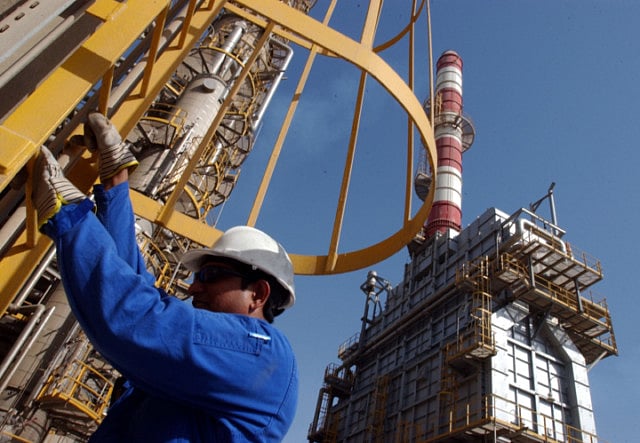What’s next if OPEC fails to deliver? The grim outlook for oil markets only grows grimmer
With more oil price volatility ahead, analysts suggest a change in investment approach

Dubai: With markets struggling to digest the steep declines in Brent prices, analysts say it may be time for a different approach when it comes to investing in the so-called liquid gold. And here is why.
Measures to contain the virus outbreak have effectively frozen the global economy: planes have been grounded, businesses shuttered and billions of people largely confined to their homes. The need for oil products such as gasoline and jet fuel has evaporated.
The world’s Organization of Petroleum Exporting Countries (OPEC) partners did manage to scurry up a historic deal in recent days, but the question on investor minds is why hasn’t the move targeted at stabilizing oil prices worked its magic yet, and why has oil prices continued to remain volatile?
Further to the record production cut agreed between OPEC and its allies, the partners are now being forced to rethink whether such cuts will be enough to stabilize oil prices going forward. What caused the change in stance?
Any effort will only fall short
The International Energy Agency (IEA) - the institution that advises oil consuming nations, shortly after the deal warned that the demand loss is so big that there is “no feasible agreement that could cut supply by enough” to offset the volatility in the near term.
Almost a decade of oil-demand growth will be erased this year as consumption plunges by about 9 million barrels a day, and the largest hit will come this month, when fuel use will tumble by 29 million barrels a day to its lowest since 1995, the Paris-based IEA estimated.
The OPEC too were in agreement. In its monthly report released Thursday, it forecasted that global oil demand will drop by 6.8 million barrels a day this year and demand for crude oil would drop to 20 million barrels a day in April, similar to the IEA forecast. It’s the least amount of crude oil OPEC has pumped since 1989.
Simply put, what this implies is the projected demand loss is far more than recent output cuts agreed to by producing nations. The OPEC and allied producers including Russia, have so far agreed to reduce output by 9.7 million bpd, and the group has signaled that many more cuts are yet to come.
How many more cuts will suffice?
The recent landmark OPEC agreement did come after Saudi Arabia and Russia - who previously disagreed on production cuts - sparked a price war that weighed heavily on oil prices and threatened to push supply to record levels as demand fell sharply.
And now that the same OPEC partners has resounded the alarm – only this time much louder – and has further agreed to more production cuts. But the dire question is how many more production cuts will be needed to stabilize the much-rattled markets, and what do investors with money to lose do till then?
Most analysts are of the view that given the scale of demand destruction this quarter, OPEC cuts – how many ever there are – will fall short of bringing the market to balance anytime soon, and this is what is being reflected in the price weakness seen since the OPEC deal.
Although the latest OPEC commentary developments are considered quite constructive and the already agreed-upon lower production volumes will to some degree alleviate the substantial excess supply of oil caused by the corona-induced demand shock, there is also another point of concern.
“The ultimate effect on oil prices will depend on the extent to which countries comply with their production cuts, as well as on the path of economic recovery and restored demand,” said Steve Wood, managing director for Moody’s Oil & Gas team.
Changing the narrative
Highlighting current oversupply concerns, Brent’s six-month contango, a market structure where prompt prices are lower than those for later dates, kept hovering around $9.8 a barrel, near levels seen before talk of a global output cut.
“Sure, crude is not completely out of the woods yet and volatility and contango remain “intimidating” across that versant, but the developments did imply a change in narrative where a further price collapse looks increasingly unlikely,” said Stéphane Barbier de la Serre, macro strategist at Makor Capital Markets.
“It could simply be that the main issue facing the energy complex is volatility at the end of the day, with the 30-day volatility now at a mind-numbing 150 per cent... Now, what that concretely means is that a daily price variation of 9 per cent is mathematically “normal” at such lofty levels!”
Go long on US crude instead
Another element to take into consideration is that the number of oil wells in operation in the US is currently falling like a stone, which analysts say it tells a lot about ongoing supply adjustments, way beyond OPEC.
“What this implies is that if you want to ride the next wave of price normalization across the oil complex, it probably makes more sense to do it on WTI than Brent henceforward,” Barbier de la Serre said.
“In other words, while we recommended to be long Brent, we now recommend to switch long Brent positions to WTI, to take advantage of the fact that the spread between both is now back to the top of its “normal” medium-term range.
“A time-tested way to look at oil has been to consider that at the end of the day it is first and foremost a risk asset like any other… In other words, there should not be any durable divorce between its dynamics and the dynamics of other risk assets in general.”
Sign up for the Daily Briefing
Get the latest news and updates straight to your inbox
Network Links
GN StoreDownload our app
© Al Nisr Publishing LLC 2025. All rights reserved.